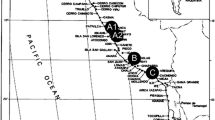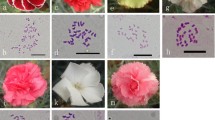Abstract
In a few hybridization experiments data were collected on the genetical basis of:
-
a.
the red-brown colour of the young flush of Meyer lemon (Citrus limon)
-
b.
the occurrence of broad-winged petioles of C. maxima and C. hystrix
-
c.
the trifoliate leaf character of Poncirus trifoliata.
The Meyer lemon is heterozygous for a colour-factor A causing the brownish-red colour of its flush. In the F1 the leaf characters of Meyer lemon in general dominate over those of C. maxima, though the width of the wings along the petiole is intermediate.
Crossing the monofoliate species C. maxima and C. hystrix resulted in a large percentage of trifoliate hybrids suggesting the presence of two dominant and complementary genes C and D for leaf dissection, one in each species.
The trifoliate character is dominant in crosses between Poncirus trifoliata and C. maxima. It is assumed that P. trifoliata is homozygous for the genes C and D.
Similar content being viewed by others
References
Batchelor, L. D. and Webber, H. J., The Citrus Industry. Vol. I. (1948) 933 pp.
Chatterjee D., Botanical nomenclature of the shaddock or pomelo. Nature, London 161 (1948): 770.
Gurgel J. T. A. and Soubihe Sobrinho J., Análisa de poliembrionia em Citrus maxime em toranjas. (Analysis of polyembryony in Citrus, particularly in pomelos). An. Esc. Agric. Quieroz 8 (1951): 727–746, P.B.A. 25 (1955) no. 3370.
Moreira S., Gurgel J. T. A., Arruda L. F. de, Poliembrionia em Citrus Bragantia 7 (1947): 69–106.
Nauriyal J. P., Self incompatibility in pumelo (Citrus maxima Merr.) Curr. Sci. Bangalore 21 (1952): 347.
Parlevliet J. E. and Cameron J. W., Evidence on the inheritance of nucellar embryony in Citrus. Proc. Am. Soc. Hort. Sci. 74 (1959): 252–260.
Soost R. K. and Cameron J. W., Production of hybrids by the use of stored trifoliate orange pollen. Proc. Am. Soc. Hort. Sci. 63 (1954): 234–238.
Torres J. P., Polyembryony in Citrus and study of hybrid seedlings. Phillipine J. Agr. 7 (1936): 37–58.
Toxopeus H. J., De polyembryonie van Citrus en haar beteekenis voor de cultuur (The polyembryony of Citrus and its significance for Citrus cultivation). Landbouw 6 (1930/31): 391–405. Alg. Proefst. Landbouw. Korte Mededeelingen 8 (1930): 1–15.
Toxopeus H. J., Die Züchtung von Unterlagen für Citrus sinensis Osb. immun gegen Phytophthora parasitica, die Ursache der “gum disease” in Java. Der Züchter 8 (1936): 1–10.
Author information
Authors and Affiliations
Additional information
Now West African Cacoa Research Institute, Moorplantation, Ibadan, Nigeria, western Region.
Rights and permissions
About this article
Cite this article
Toxopeus, H. Notes on the genetics of a few leaf characters in the genus citrus. Euphytica 11, 19–25 (1962). https://doi.org/10.1007/BF00044800
Received:
Issue Date:
DOI: https://doi.org/10.1007/BF00044800




